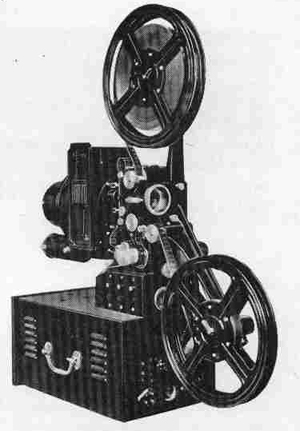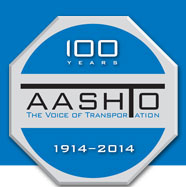
August 20, 2014
Transportation Then & Now: Transportation for a Competitive America

Motion Pictures
The following article, published in the January 1938 edition of American Highways, was prepared by E.J. Amey of the Texas Highway Department. The article discusses how film and in particular motion pictures can help state highway officials get their message across and promote the progress and priorities of their agencies in serving the public. The article, in other words, taps into and amplifies something that AASHTO and its member departments have long recognized and sought to harness: the power and potential of the latest available images to better communicate our respective stories. Back in 1913, for example, an event promoting good roads in Missouri had the governor of both that state and neighboring Kansas perform highway work while being filmed for posterity by what several newspaper accounts of the time called “moving picture machines.” The January 1924 edition of American Highways featured a piece about then-President Calvin Coolidge starring “in a new motion picture depicting the advantages of improved highways and showing how the community went about securing them.” This article also mentions that copies of that three-reeler would be made available in the near future for the use of state highway departments. All of these efforts, including those described in the article posted here, are among the precursors to today’s wide-ranging and regular of use of moving images to get the message out and communicate who we are – key examples involve AASHTO’s TransportationTV and the various online video features and applications of our member departments.
This subject deals with methods of publicity which seem to have been used very little by State Highway Departments. Motion pictures have been made by some States, using 16mm films rather than 35mm,, the size used by theaters, not because the cost of making 35mm film is so prohibitive but because the cost of projection machines for 35mm film is high and the machines themselves would be difficult to transport from one place to another.
The usual practice is for someone in the Highway Department who shows a particular interest and aptitude for such work to make the films, and these persons have, with some application, study, and experience, produced most satisfactory results. By using regular employees, the cost of the motion picture is reduced, and the cost of preparing 400 feet of 16mm picture, including film, develop¬ing, cutting, arranging, and insertion of titles, runs about $50. This does not include labor or photographic camera equipment. Sound film may be added, and a duplicate film with sound effects will cost approximately $130 per reel; additional copies with sound effects at approximately $90.
Motion pictures of a technical nature are now being used to some extent to illustrate construction and maintenance work, but there are possibilities of using these in traffic and safety surveys, laboratory procedure, etc. As these pictures are being shown to groups of highway employees, or to schools, county highway groups, and other groups who are interested in them, a discussion of technical phrases of work may be had in an effort to correlate methods of construction and maintenance throughout the State. In State Highway Departments that supervise activities of the State Highway Patrol, motion pictures play a very definite part in carrying safety campaigns to the traveling public.
The field for non-technical pictures varies greatly according to the location of the State, density of traffic, etc., and what amounts to a necessity in one State will not be needed in another. Wisconsin has made pictures of:
Wisconsin schoolboy patrols,
Wisconsin pedestrians,
Wisconsin highway signs,
The bicycle on the highway,
Driving hazards,
While in Texas the sight of a pedestrian on some of our long, open spaces would be a novelty, and the distance between towns and cities is enough to discourage cyclists. Under this heading can be included motion pictures of scenic subjects, such as mountains and ocean shore highways, department facilities, etc. In Texas, we have had a very gratifying attendance at showing of films in color of roadside parks, flowers and beautification work, by showing the films in connection with flower shows held annually in each of our 25 divisions, at which wild flowers gathered from the highway right of way are displayed.
The distribution of motion-picture reels is not made through theaters. The16mm film is not adaptable to that use--theater equipment requiring 35mm film -- and in general the success attained through picture houses has not been commensurate with the effort expended. The present double-feature practice of theaters, the policies of national booking, and the universal attitude that "something for nothing" has little value, have all been contributing factors to the lack of successful distribution in this field.
To successfully utilize theater outlets, educational films of this character should consist of "shorts" of not over 1,000 feet, and the informative or educational purposes should be cleverly disguised behind an amusement or entertainment feature. The showing of highway films has been before commercial clubs, lodges, civic organizations, good roads and automobile associations, garden clubs, women's clubs, service groups, schools, county highway groups, State legislatures, and other gatherings. Films are rented or loaned to organizations when additional publicity will be obtained. At the Texas Centennial Exposition in Dallas in 1936, since we were unable to spend highway funds for a State highway display, we furnished the Texas Good Roads Association with several good films, and they were shown eight hours per day for two and one-half months to an ever-changing audience.
In the matter of still photography, it seems to be a common practice for the State Highway Departments to take pictures of construction and maintenance work. Division engineers, and in many States resident engineers, are furnished with cameras and record progressive stages of work. A photographic record in controversial matters relating to claims by contractors is especially valuable, and the same is true of scenes where right of way is to be obtained.
Scenic views are useful in many ways and have several types of distribution, including illustrated booklets to stimulate travel, State highway magazines, travel maps, and articles in magazines issued by outside interests. Albums of interesting scenes on and adjacent to highways will entertain callers in your reception rooms and make their wait less tiresome.
The use of still pictures need not and should not be confined to pictures obtained in the department. It has been found that many fine pictures are avail¬able through amateur and commercial photographers, chambers of commerce, and civic organizations.
I believe all State Highway Departments at some time have made use of exhibits. The selection of suitable subject matter and the method of exhibition is dependent largely upon the nature of the exhibit and upon the facilities offered. Moving or stationary models seem to be used to a small extent, and large still photographs featuring scenic attractions have been found very attractive. Models of pavement, grade separations, bridges, and subgrade sections have been used to advantage.
Technical graphs and charts are used to show sources of highway revenue and the distribution of highway funds, the trend of construction and maintenance costs, and many other comparisons. Illuminated travel maps and colored photographs are used to some extent, as is a display of standard highway signing.
There is a good field for exhibits, ranging from a small, simple exhibit in hotel lobbies to large, elaborate exhibits at colleges during special events, conventions, State fairs, expositions, and at other large gatherings. Safety campaigns are usually aided by the use of large posters and displays calling attention to unsafe practices and requesting careful driving.
The States that have been most progressive in the use of these mediums have found photography, both still and moving pictures, of utmost importance and usefulness, and are seeking its reasonable extension. Many States have not been progressive along these lines, and personally I feel that these States could afford and would be justified in expending a little more money through a public relations department; and by means of properly prepared exhibits the public could be informed of the department's activities and progress.












